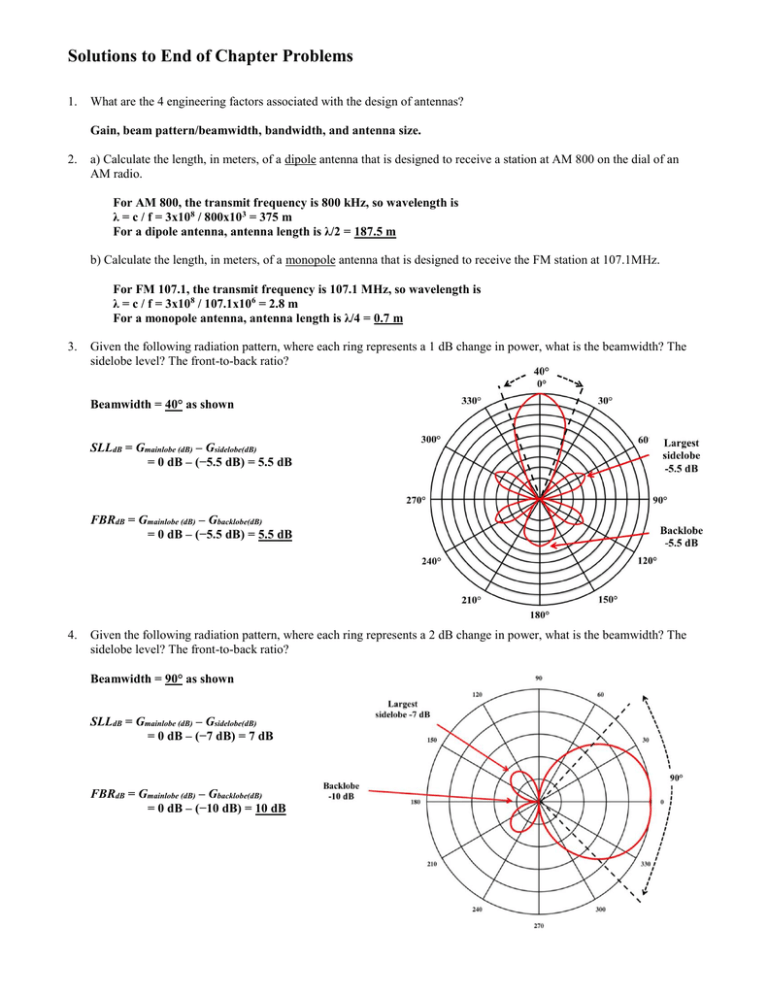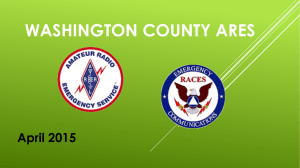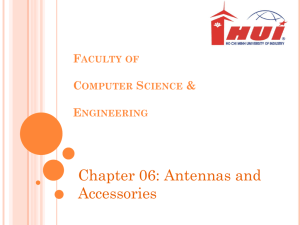Solutions to End of Chapter Problems
advertisement

Solutions to End of Chapter Problems 1. What are the 4 engineering factors associated with the design of antennas? Gain, beam pattern/beamwidth, bandwidth, and antenna size. 2. a) Calculate the length, in meters, of a dipole antenna that is designed to receive a station at AM 800 on the dial of an AM radio. For AM 800, the transmit frequency is 800 kHz, so wavelength is λ = c / f = 3x108 / 800x103 = 375 m For a dipole antenna, antenna length is λ/2 = 187.5 m b) Calculate the length, in meters, of a monopole antenna that is designed to receive the FM station at 107.1MHz. For FM 107.1, the transmit frequency is 107.1 MHz, so wavelength is λ = c / f = 3x108 / 107.1x106 = 2.8 m For a monopole antenna, antenna length is λ/4 = 0.7 m 3. Given the following radiation pattern, where each ring represents a 1 dB change in power, what is the beamwidth? The sidelobe level? The front-to-back ratio? Beamwidth = 40° as shown SLLdB = Gmainlobe (dB) – Gsidelobe(dB) = 0 dB – (−5.5 dB) = 5.5 dB FBRdB = Gmainlobe (dB) – Gbacklobe(dB) = 0 dB – (−5.5 dB) = 5.5 dB 4. Given the following radiation pattern, where each ring represents a 2 dB change in power, what is the beamwidth? The sidelobe level? The front-to-back ratio? Beamwidth = 90° as shown SLLdB = Gmainlobe (dB) – Gsidelobe(dB) = 0 dB – (−7 dB) = 7 dB FBRdB = Gmainlobe (dB) – Gbacklobe(dB) = 0 dB – (−10 dB) = 10 dB 5. The power applied to an antenna with a gain of 4 dB is 13 W. What is the EIRP? EIRP = Pt Gt = 13 W x 100.4 = 32.65 W 6. What does it mean for an antenna to have directivity, and what are the advantages and disadvantages of a directional antenna? Directivity means the antenna has the ability to focus transmitted power in a certain direction, rather than all directions like an isotropic antenna. Advantages: Can transmit with less power for the same range, or can transmit a longer range with the same power. Can reduce interference problems with other transmitters at the same frequency. Can reduce likelihood of eavesdropping. Can reduce detectability of transmitting. Disadvantages: With high gain, antennas can be very large. Also, harder to keep pointing at the receiver in a mobile situation. 7. Name and describe the three basic elements in a Yagi antenna. Driven element: a half-wave dipole antenna Directors: metal rods that help point a Yagi’s antenna in a certain direction. Reflectors: metal rods that reflect the dipole’s transmission towards the directors. 8. The length of the driven element in a Yagi antenna is 900 mm; what is its operating frequency? λ/2 = 0.9 m, so λ = 1.8 m. 9. f = c / λ = 3 x 10 8 / 1.8 = 166.67 MHz The mainlobe of an antenna has a maximum gain value of +18 dB at its peak point of forward direction. The same antenna has a gain of −5dB at the peak point of its rear lobe. Determine the front-to-back ratio of the antenna. FBRdB = Gmainlobe (dB) – Gbacklobe(dB) = 18 dB – (−5 dB) = 23 dB 10. Yagi antennas A and B both have a driven element designed to transmit/receive 100 MHz. Yagi antenna A has 1 director and 3 reflectors, while Yagi antenna B has 1 director and 7 reflectors. Describe the differences you would expect to see in their radiation patterns. More parasitic elements (directors and reflectors) provide a narrower beamwidth. Yagi antenna B should have a narrower beamwidth than Yagi antenna A.


